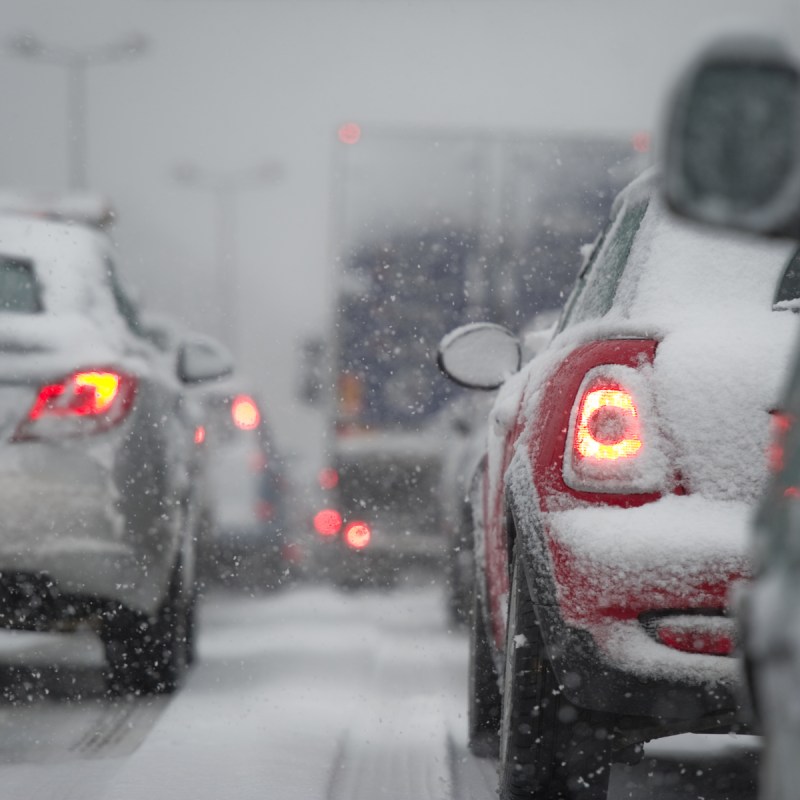
If you live or travel somewhere that experiences winter weather, you know cold, snowy, and icy conditions can have a significant impact on travel times. Unfortunately, these conditions often play a role in traffic accidents and lengthy delays as well.
Videos by TravelAwaits
It’s always smart to have emergency supplies in your vehicle, but it becomes even more important in the winter so you can deal with unexpected situations. That preparation is sure to pay off in the event you are in an accident or encounter travel delays.
To help you better prepare for winter travel, here are the 14 essential items you should always have in your vehicle this winter.
1. Combination Ice Scraper And Snow Brush
Of course, it’s always important to clear your vehicle’s windshields of snow and ice before traveling. And if you are involved in an accident or encounter a long delay, snow and ice can quickly pile up while you wait. Having a long-handled combination ice scraper and snow brush handy helps you clean windshields quickly.
2. Windshield De-Icer
Clearing ice from a windshield can be a lengthy process using an ice scraper. If you keep a bottle of de-icer handy, you can use it on your vehicle’s windows and windshields to remove ice quickly. For faster results, you can apply the de-icer and then begin scraping the ice with your combination ice scraper and snow brush once the ice begins to melt.
3. Jumper Cables Or Jumper Box
It’s always a good idea to have a pair of jumper cables in your vehicle during winter — that’s because low temperatures reduce the cranking power of a battery — but sometimes there are no cars around to do the jumping. That’s why we recommend keeping a charged jumper box in your car at all times, but especially during winter. Most modern jumper boxes also include USB ports to charge your devices as well.
4. Shovel And Sand/Kitty Litter
You’ll find a shovel is extremely useful in several situations. Look for a compact shovel or one that folds or is collapsible so it’s easy to store. You can use it to remove snow from around your vehicle’s tires if you run off the road, helping the tires get more traction.
Furthermore, if your vehicle’s tires are spinning, you can use a shovel to put dirt or snow under the tires. You can also keep sand or kitty litter on hand. The sand or kitty litter will provide the extra grit the tires need to gain traction. You can even spread the gritty stuff with the shovel you have on hand.
Pro Tip: In a pinch, you can also place your car’s floor mats under its tires to gain traction.
5. Warm Clothes
If you are involved in an accident or encounter a lengthy delay, you may not be able to run the car’s heater as long as you’d like. Be sure your vehicle has extra coats, hats, and gloves for you and anybody traveling with you so you can all stay warm. You can also put disposable hand warmers in your gloves and socks for an extra measure of heat.
Pro Tip: Be sure you also pack a pair of snow boots. You’ll need them if you have to get out of the vehicle to clear snow or icy slush that’s around the tires.
6. Blankets
That said, an extra coat may not be enough to keep you warm. Be sure to keep some blankets in your vehicle so you can cover up if necessary. Thermal blankets made of dual-sided aluminized mylar not only retain body heat, they also repel rain and snow in case you are outside your vehicle.
7. Roadside Flares, Reflective Triangles, Or LED Flashers
If your vehicle does run off the road or you are involved in an accident, you’ll want to ensure it’s visible so help can find you — and prevent another vehicle from hitting you. Flares, hazard triangles, and LED flashers will all help mark your location and give other drivers notice to reduce their speed and avoid your vehicle.
8. Flashlight
Simply put, a flashlight will help you see what you’re doing in the dark. It can also make looking for any of these materials easier if they are pushed into the back of your car’s trunk. Plus, if you don’t have flares or hazard triangles, you can always use the flashlight to signal passing vehicles.
9. A Tow Strap
You’ll need a tow strap to free any trapped vehicles. If you are using a tow strap, make sure someone stays in the car being rescued to steer and use the brakes as needed.
10. Portable Phone Charger And Battery
During emergencies, you’ll want to call for help — and that’s no time to realize your cellphone’s battery is dead. Be sure to have a car charger in your vehicle. It’s also important to keep a portable battery or power bank on-hand. That way you can charge your phone even if the vehicle’s battery is dead.
11. First-Aid Kit
It’s always important to keep a first-aid kit in your vehicle. It should include bandages, adhesive tape, antibiotic ointment, scissors, gauze, and any other items you may need in case of injury.
12. Non-Perishable Food And Water
To be prepared for especially long delays or emergencies, keep non-perishable foods, such as protein or granola bars and canned goods, in your vehicle. Be sure to also pack enough water for everyone in the vehicle in case you are stuck for hours.
Pro Tip: If you are traveling with pets, be sure you have food and water for them as well.
13. Personal Hygiene Items
If you are stranded for a long time, it may be difficult to take care of personal hygiene. To help, make sure your emergency kit has some moist towelettes and even toilet paper.
14. Extra Windshield-Wiper Fluid
Extra windshield-wiper fluid may not be necessary in an emergency, but vehicles use more wiper fluid in the winter as drivers struggle to clean windshields. As long as you’re packing a winter essentials kit, be sure to add extra wiper fluid so you’ll be prepared.
Pro Tip: If you plan to store a jug of wiper fluid in your vehicle, make sure you buy a fluid formulated for winter. That way it won’t freeze.
Know Before You Go
Of course, if you are planning to travel in the winter, be sure your vehicle’s tires are properly inflated and have plenty of tread. You’ll also want to ensure your vehicle always has at least a half tank of fuel so it doesn’t run out at an inopportune time.
Finally, if your vehicle does run off the road, AAA reminds everyone to stay with your vehicle: It not only provides shelter, staying with the vehicle also makes it easier for rescuers to find you.
AAA also notes that if you are involved in an accident or encounter a lengthy delay, it’s important to conserve fuel in your vehicle. That can be accomplished by only running the engine and heater long enough to remove the chill, and then shutting it off.
You can learn more about being safe while traveling in our travel tips and safety coverage.
